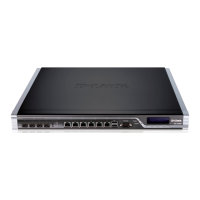or NATed by the NetDefend Firewall.
Note: PPPoE has a discovery protocol
To provide a point-to-point connection over Ethernet, each PPP session must learn the
Ethernet address of the remote peer, as well as establish a unique session identifier.
PPPoE includes a discovery protocol that provides this.
PPPoE cannot be used with HA
For reasons connected with the way IP addresses are shared in a NetDefendOS high availability
cluster, PPPoE will not operate correctly. It should therefore not be configured with HA.
Example 3.16. Configuring a PPPoE Client
This example shows how to configure a PPPoE client on the wan interface with traffic routed over PPPoE.
CLI
gw-world:/> add Interface PPPoETunnel PPPoEClient
EthernetInterface=wan
Network=all-nets
Username=exampleuser
Password=examplepw
Web Interface
1. Go to: Interfaces > PPPoE > Add > PPPoE Tunnel
2. Then enter:
• Name: PPPoEClient
• Physical Interface: wan
• Remote Network: all-nets (as we will route all traffic into the tunnel)
• Service Name: Service name provided by the service provider
• Username: Username provided by the service provider
• Password: Password provided by the service provider
• Confirm Password: Retype the password
• Under Authentication specify which authentication protocol to use
(the default settings will be used if not specified)
• Disable the option Enable dial-on-demand
• Under Advanced, if Add route for remote network is enabled then a new route will be added for the
interface
3. Click OK
3.4.5. GRE Tunnels
Overview
The Generic Router Encapsulation (GRE) protocol is a simple, encapsulating protocol that can be
used whenever there is a need to tunnel traffic across networks and/or through network devices.
3.4.5. GRE Tunnels Chapter 3. Fundamentals
122

